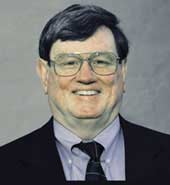|
Executive Interviews: Interview with James M Higgins on Strategy Execution
September 2008
-
By Dr. Nagendra V Chowdary
 Dr. James Higgins
Dr. James Higgins Dr James M Higgins is Cornell Professor of Innovation Management at Crummer Graduate School of Business Rollins College Florida. 
You have said, "The 8 Ss of Strategy
Execution" is a heuristic that enables
senior management to more
readily enact, monitor, and assess
the original McKinsey 7Ss model.
Why do you call it is a heuristic? In
what way does your model differ
from McKinseys 7S framework?
I have labeled the 8Ss as a heuristic
because it is a methodology for solving
major problem in execution the
problem of not aligning key organizational
cross-functional elements with
strategy. The 8S's are based on the McKinsey
7Ss framework but with a few
changes. The McKinsey 7Ss are
strategy, structure, systems, style,
staff, skills, and shared values.
|
|
In
working with firms to determine their
context for innovation, it became evident
to me that reSources were a pivotal
element to strategic success that was not identified in the McKinsey
7Ss. And for me, Skills belonged under
the Strategy label. So I substituted
reSources for Skills in the 7Ss
implementation model. In addition to
using this heuristic, it became clear to
me that the Strategy element needed
purposes in order for this part of
strategy to be fully understood by the
user. The same kind of rationale
caused me to include processes with
the Systems element. Finally, I felt
like the bottom line focus needed to
be added to the model to draw attention
to it for the user. This caused me
to add the 8th S Strategic Performance. -
For a successful strategy execution,
cross functional issues are important.
Yet they are overlooked. Why
do you think cross functional issues
are overlooked, and what are the
consequences and implications of
overlooking cross functional issues?
Cross functional issues are overlooked
for a number of reasons.
Among these are: when a functional
organizational structure is dominant,
it obscures the need for cross functional
analysis; many firms are still
based on non collaborative structures;
firm leaders are unaware of the
need for cross functional analysis
functional backgrounds rule; they are
unaware of cross-functional implementation
models; they know of
cross functional models but have
chosen not to utilize them. The beauty of the McKinsey 7S's
model and subsequently the 8S's
model which is based on the
McKinsey model is that they are
cross functional. The consequences of failing to consider
cross functional strategy issues
are often disastrous. The primary result
is reduced performance. In the
turbulent environments that organizations
confront today, cross functional
operations are imperative. Strategy
considerations could hardly be otherwise -
What, according to you, are the secrets
to successful strategy execution?
What best practices from very
successful companies do you observe?
What does your research say
on the critical success factors for effective
strategy implementation?
The secrets to successful strategy execution
are: actively involved leadership,
alignment of the 8Ss, clarity of
the strategy, continuous communication,
managing cultural artifacts to reinforce
the strategy and its related values,
putting execution on employee
performance appraisals and rewarding
performance. The best practices I have observed in
very successful companies are: Some
type of balanced scorecard approach
to execution, clarity of strategy, alignment
of Ss, strategy related objectives
on performance appraisals, rewards
tied to performance, managerial follow
up at all levels, effective communication,
and cultural artifacts management. My research has focused on what
leads to successful innovation. The
following are what I have found to be
themost critical elements in that environment:
Alignment of the 8Ss including
a strategy that is known
and understood by employees; customer
focus; a structure that enhances
innovation (open source, new venture,
collaborative, innovation labs
product development division independence,
etc., are all being employed
in different situations today);
a performance management system
where objectives and rewards are
linked to strategy rewards vary by
which employees we are examining
(on average creatives seek intrinsic rewards,
others seek more extrinsic rewards);
a leadership style that is tailored
to the requirements for leading
creatives versus those for leading others
in the workforce; a vision for innovation;
the right composition of
staff mixing big bang innovators with incremental innovators, or not;
for non creatives especially, development
of creativity and innovation
management skills; sufficient resources
allocated to the project, product/
service, process or business
model being innovated; managing
culture but especially cultural artifacts. In a related vein, while the following
is not my research, I find the results
of some recently reported research by
Booz & Company members Alex
Koster, Michael Szczepanski, and
Christoph Lechner to be especially
intriguing. Based on in depth Interviews
with 50 global leaders and an
extensive quantitative analysis of
some 200 global firms with respect to
their growth strategies, these researchers
found that successful best
practices depend on which of the
four "growth modes" the firm uses.
These four modes are different from
one another primarily in the form of
control that senior executives use.
Self organizing firms are characterized
by low control of content and process.
Agenda setting firms are characterized
by high control of content and
low control of process. Context setting
firms are characterized by low
control of content, and high control of
process. And directing firms are characterized
by high control of content
and process. Best practices areas are
identified. The researchers then explain
how these practices vary according
to which of the growth
modes the firms employ. For example,
self organizing firms require
intrinsically motivated employees
which are often hard to find. In this
case the company needs to pay close
attention to recruitment, job design
and so on. The best practice in a context
setting firm relative to employees
would be related to establishing longterm
risk reward practices.
1.
Business Strategy Case Studies
2. ICMR
Case Collection
3.
Case Study Volumes
|
